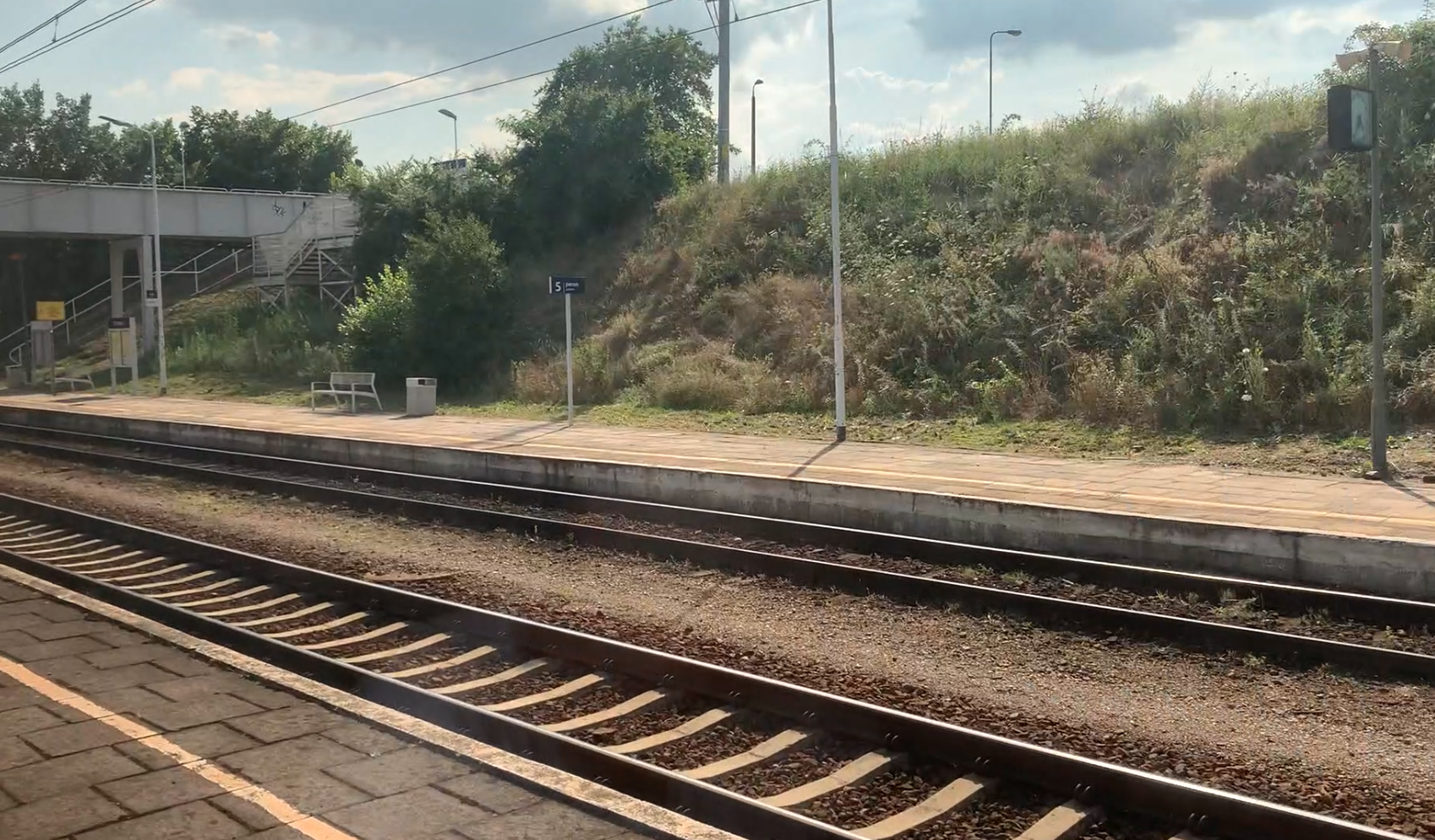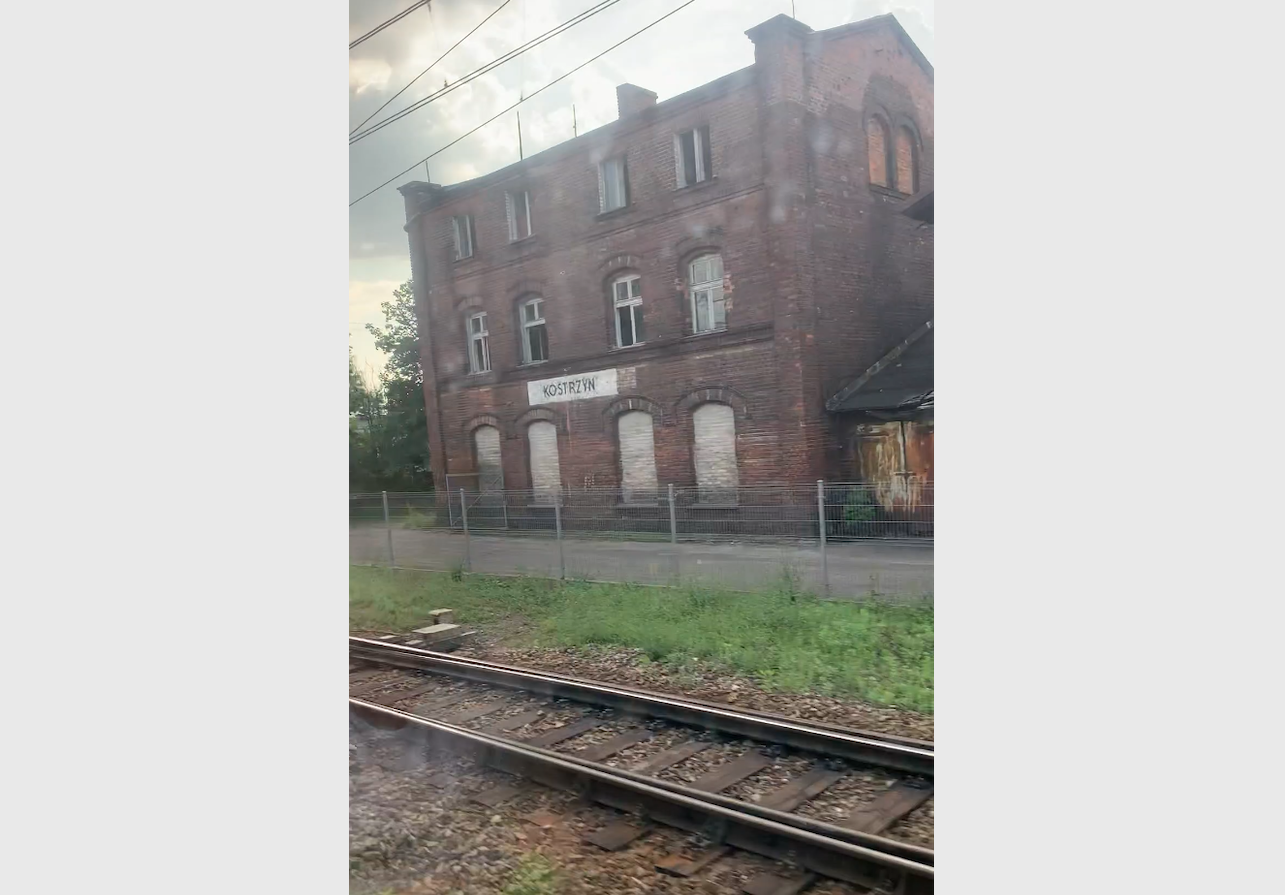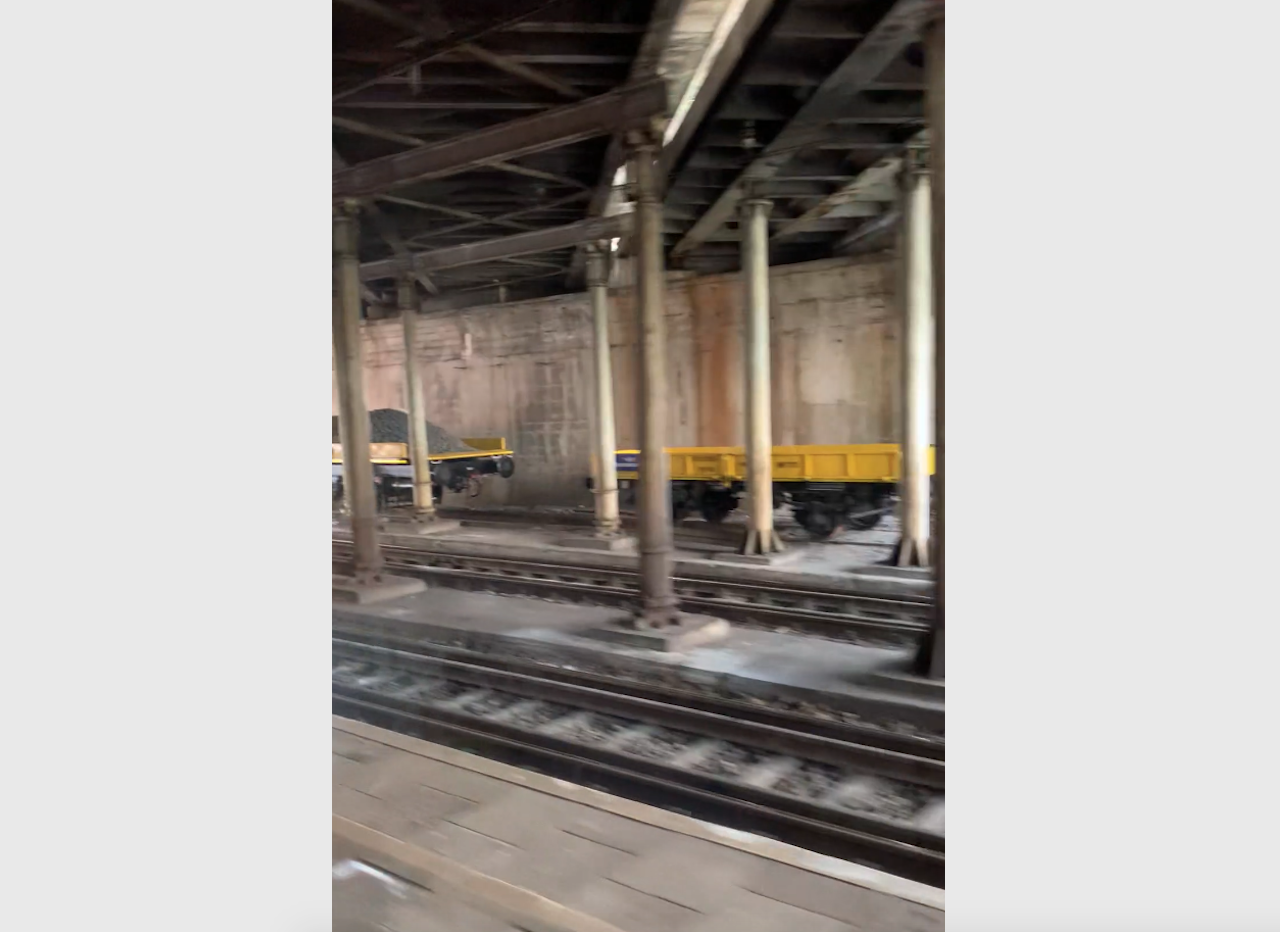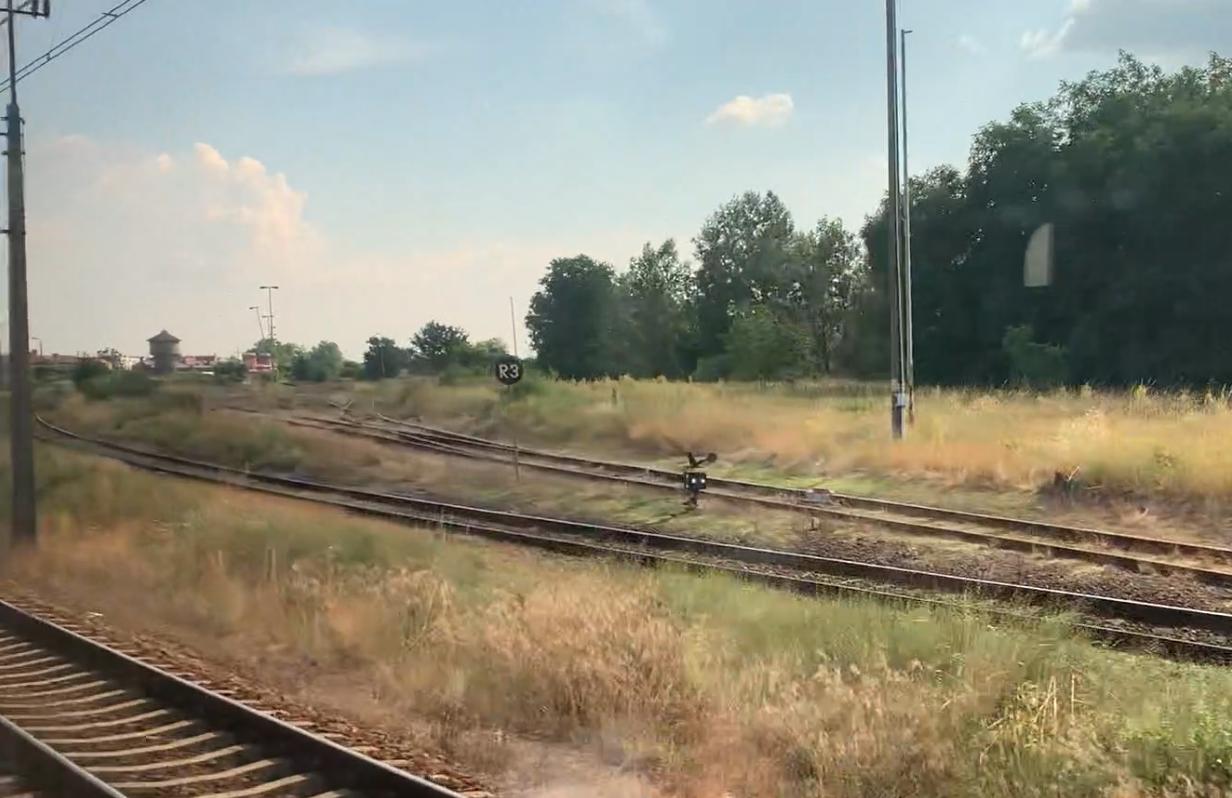Kostrzyn nad Odrą 2022-02-23
PKP Kostrzyn nad Odrą.
Kostrzyn on the Oder. is one of the most interesting stations in Poland. It is one of two two-storey buildings in Poland. The other one is the railway station in Kępno. The second characteristic feature of the station in Kostrzyn is the electrification of the north-south route, and the east-west route remained unelectricated.
The city of Kostrzyn on the Oder.
Kostrzyn on the Oder. is a settlement founded in the 13th century. As a result of World War II, the city was divided between Poland and Germany, because the greats of this world decided that the Polish-German border would be on the Odra River. The city belongs to the Gorzów Wielkopolski County and the Lubuskie Province. In 2019, the city had a population of 17 750 people. The geographical coordinates of the city are 52 ° 35′18 ″ N 14 ° 40′00 ″ E.
Until 1945, the city was called Küstrin. In the period 1946 - 2002, the name Kostrzyn, and from 2003, Kostrzyn on the Oder., not to be confused with the German Küstrin. In fact, Polish Kostrzyn lies on the Warta River, which flows into the Oder here.
The Second World War, started by the Germans and Russians, led to the loss of a large area by the Germans. Poland lost the Polish Borderlands, and gained the so-called Regained Territories, which once belonged to the Piasts. It was the former Lubusz Land. As a result of the Russian-German fratricidal fights in 1945, the very center of the city was destroyed in 100%. Kostrzyn is considered to be the most damaged city in Poland, sometimes called "Polish Hiroshima". The Old Town of Kostrzyn is now an overgrown field with the remains of the ruins of the old buildings. After the Second World War, some buildings of the fortress city were restored: the Berlin Gate, the Chyżańska Gate, the Filip Bastion, the Brandenburg Bastion and the Kattego Promenade. The area of Kostrzyn upon Oder is 46.18 km2. 40% of the city's area is covered by forests and forest land. Forests are located in the northern part of the city.
In the early Middle Ages, Kostrzyn belonged to Greater Poland. In 1232, Władysław Odonic, the Duke of Greater Poland, granted the Kostrzyn lands to the Knights Templar. In 1249, Kostrzyn became the capital of the Kostrzyn castellany. Kostrzyn in 1261 was referred to as a town, and that year the city passed into the hands of the Brandenburgers. In 1402, the city was going to be sold to Poland, but was eventually sold to the Teutonic Knights. In 1454, the Teutonic Knights sold the city of the March of Brandenburg in order to have funds to conduct a war with Poland. From the 16th century, the city was expanded as a fortress. Due to different religions; Protestantism, Calvinism, Lutheranism, numerous religious fights took place here. Already at the beginning of the 18th century, Kostrzyn was a large fortress. Another extension took place during the Thirty Years' War (1631). As the city was frequently flooded, in 1785, partial regulation of the rivers Warta and Odra was started. The Frederick William canal was dug and since then the Warta flows into the Oder north of the fortress. The city itself developed on the right bank of the Warta River and the left bank of the Odra River. At the beginning of the 19th century, the first factories were established in the city. In 1903, a horse-drawn tram line was established, which in 1925 was converted into an electric tram.
On January 31, 1945, Russian troops approached Kostrzyn and the last part of the fratricidal fighting began; battle for Berlin. The city of Kostrzyn was shot continuously until March 30, 1945. Then the Old Town and the citadel fell. 8,278 houses were destroyed.
The greats of this world have determined that the Odra River will be the border between Germany and Poland. Kostrzyn divided between two countries. The Old and New Towns were incorporated into Poland. Long Przedmieście and Kietz remained in Germany. Initially, Kostrzyn was a closed city, the only inhabitants were railroad workers and customs officers. In 1954, the construction of the then largest paper and cellulose factory in Poland, "Zakłady Celulozy i Papieru", began. Currently, the factory is called Arctic Paper. Only in 1992, the border crossing with Germany (West Germany) was opened.
Road transport.
There are two national roads and one voivodeship road leading to Kostrzyn upon the Oder. National road No. 22: state border - Kostrzyn nad Odrą - Gorzów Wielkopolski - Wałcz - Człuchów - Malbork - Elbląg - Grzechotki - state border. National road No. 31: Szczecin - Gryfino - Kostrzyn nad Odrą - Słubice. Voivodeship road No. 132: Kostrzyn nad Odrą - Gorzów Wielkopolski.
PKP Kostrzyn nad Odrą.
From 1646, a postal line from Berlin to Ducal Prussia ran through the city.



When the state of Prussia decided to build a standard-gauge railway network, it was certain that the city of Kostrzyn would be in this network. Nay; there will be a railway junction here. For various political and economic reasons, the Berlin-Szczecin line was first established. Then the line Szczecin - Stargard Szczeciński - Krzyż Wielkopolski - Poznań. A railway line Berlin - Kostrzyn - Krzyż is planned in Kostrzyn as part of the "Ostbahn". This line was financed by the state of Prussia. On the other hand, the railway route Szczecin - Kostrzyn - Zielona Góra and further to Wrocław was financed by factory owners. As a result, the railway station in Kostrzyn on the Oder has two levels.
The second special thing at the Kostrzyn nad Odrą station is the fact that the "Nadodrzanki" route (south - north) No. 273 has been electrified. And the route (east - west) No. 203 is not electrified. It resulted from other priorities of Poland than former Prussia.
In the 1930s, there were five railway stations and stops in Kostrzyn. Currently (2022) there are three stations; two goods and one passenger.
The railway station in Kostrzyn on the Oder was successively named: Cüstrin Vorstadt 1857 - 1900, Cüstrin Neustadt Hauptbahnhof 1901 - 1930, Küstrin Neustadt Hauptbahnhof 1931 - 1945, Kostrzyn 1945 - until now (2022). Geographic coordinates: 52 ° 35′29.5 ″ N 14 ° 38′50.0 ″ E. The station serves connections both inland and to Germany. In 2019, the station served 1,900 passengers a day. About 70 trains a day stop at the Kostrzyn station.
The railway station in Kostrzyn on the Oder was built in the period 1872 - 1874. Despite several renovations, the shape of the building has not changed. Engineers designed the building as a double-winged building as close as possible to the viaduct where the two main railroads intersect. The author of the project was Eduard Römer, a German architect of stations and buildings of the Prussian Eastern Railways. During the Second World War, the station was not completely destroyed. Railway passenger traffic was restored in June 1945. The station was rebuilt around 1950. In the 70-years of the 20th century, the station was included in the list of monuments.
The last major renovation of the station was carried out in the period 2012-2014. As part of the modernization, the historic façade was renovated and completed. All rooms related to passenger service were also renovated: the hall, ticket offices, toilets. The station has been adapted to the needs of disabled people. Architectural barriers were removed, toilets were adapted and lifts were installed. PKP also took care of commercial space in the station building. There are shops, a newsagent's, and gastronomy at the travelers' disposal. The renovation was estimated at PLN 7.7 million. The contractor for the renovation of the railway station in Kostrzyn nad Odrą was the Łódź-based company SKB Development.
Railway routes: No. 203 Tczew - Küstrin Kietz. No. 273 Wrocław Główny - Szczecin Główny. No. 410 Grzmiąca - Kostrzyn.
The railway line No. 203 runs at the top of the station. After the Second World War, No. 330, and then No. 345. Currently (2022) the route is still not electrified. Passenger trains from Berlin and trains from Gorzów Wielkopolski and Myślibórz stop on the upper platforms. When the border crossing with the German Federal Republic was opened in 2002, and then Poland entered the Schengen area, most trains came to Kostrzyn from Berlin. Further, the Germans travel to their homeland by Polish railways. Currently, on the route Kostrzyn (Poland) - Kustrin-Kietz (Germany), trains run every hour during the day and it is the most numerous connection from Kostrzyn on the Oder. Many Poles use these trains to commute to work in Germany. In 2020, the plans to electrify the railway line No. 203 were announced, but it will not happen earlier than in 2023. First, there was the electrified section Piła - Krzyż - Kostrzyn on the Oder.
At the bottom of the Kostrzyn nad Odrą station, there is a railway line no. 273 Zielona Góra - Rzepin - Szczecin, ie the so-called "Nadodrzanka". After the Second World War, No. 325/350, and then No. 355/366. When the railway line No. 414 existed, trains from Gorzów Wielkopolski going through Rudnica also stopped here.

Historic railway line No. 414.
Kostrzyn also had a local railway line: Kostrzyn - Gorzów Wielkopolski, namely Chyrzyno (a railway station) - Gorzów Wielkopolski Zieleniec. After the war, the trail was No. 327d, then No. 346. The trail was 40.57 m long. It connected the following stops: Żaczyn, Czarnów, Słońsk, Lemierzyce Gaj, Muszkowo, Krzeszyce, Krasnołęg, Kołczyn, Rudnica, Płonica Bolemin, and Ulim. Generally, the railway line ran along the national road No. 22. The line was built in the period 1884 - 1915. The first train traveled along a part of the route in 1886. After the Second World War, the route was rebuilt and was used to transport goods and passengers. In 1992, passenger traffic was suspended, and in 2005, freight traffic. Currently (2022) the trail is impassable and dismantled. There are only a few tracks left in the railway crossings. In 2011, local governments wanted to build a bicycle path on the former railway route. However, the estimated investment cost of PLN 20 million exceeded the capacity of the municipalities.
Railway bridges on the Warta and Odra rivers.
Railway bridges on the Warta and Odra rivers along the line No. 203 required renovation. As of 2011, only one of the two railway tracks was operational. The bridges were heavily loaded because 30-40 trains passed through this way during the day. In 2015, the Germans decided to build a new bridge over the Oder. Poland was left with the renovation of the railway bridge over the Warta River.
Due to the flood risk and the improvement of navigability of both rivers, the bridges were to be raised higher, and the railway embankment between the bridges was to be raised and widened. The renovation started in August 2021. The tracks were removed, leaving only the truss of the bridge. Worn-out steel structures were replaced with new ones. Over 200 tons of steel structure were replaced. The works were completed in December 2022. The investment cost is PLN 26 million. After the current renovation, the running speed of the train is 120 km / h.
The railway bridge over the Warta River consists of two parallel bridges. Each of them has three spans. It is a truss structure made of steel by riveting. The abutments were made of dark brick structures, typical for this area. During the Second World War, the bridges were blown up. The crossing was provisionally launched in June 1945.
As part of the same task, the railway viaduct over Niepodległości Street near the Kostrzyn nad Odrą station was renovated. The new railway bridge over the Odra River, made by the Germans, is a completely new structure. The bridge is single-span reinforced concrete. There are two reinforced concrete arches running upstairs, and the driving level is suspended on a spatial, steel network, so fashionable in recent years. In addition to the main span, the tracks run on a flyover. This increases flood safety. The old bridge consisted of two parallel, four-span truss bridges.
On the route No. 273 there is a bridge over the Warta River and a bridge over the Warta backwaters. Both bridges are double truss. There are five spans across the Warta River. Three spans across the pool. The bridges are riveted. The bridges are regularly maintained, as 50 - 60 trains pass through the bridges a day.
Infrastructure of the Kostrzyn on the Oder station.
Railroads No. 203 and No. 273 are connected with each other by two connectors. One switch runs from the west, Line No. 203, in the north direction to the line No. 273. The other from the line No. 203, from the east, also northward to the line No. 273.

On the north side of the station there is a historic water tower, round, clearly visible from the upper platforms. Behind the water tower there were two fan-shaped locomotives. The first one in the 1960s was completely dismantled. You can see the outlines of the building and the turntable. Further on, there is the second fan-shaped locomotive, which is still in operation. There are several railway buildings nearby. Some of them are used for non-rail purposes: an automotive shop and a construction depot. There is a freight station much further north.
Other railway structures are on route No. 203 and No. 410 to the east. Here is a second freight station operated exclusively by diesel locomotives. There is a second water tower in this part of the station. It can be seen from the provincial road No. 132 (Gorzowska Street). It is double, regular octagonal and elongated octagonal. There are no roofs on the towers. The towers are scheduled for demolition. Both freight stations are heavily used. There are historic buildings of the railway control stations at the stations. There are light and shaped semaphores at the stations.
The third depot was located between routes No. 203 and No. 410, near the water tower. Only a few buildings remain of the depot, which are no longer used.
The fourth depot was located south of the Kostrzyn station on Niepodległości Street. The facilities have long been adapted to other railway purposes. It was the first depot in Kostrzyn. The first water tower was probably here.

From route No. 203 towards Germany, before the Warta River, a railway siding runs off to a paper factory and a heating plant. The bottom platforms have the numbers: Platform 3, Platform 4, Platform 5. The middle platform, due to its narrow width, has been excluded from use. As a result, two platform edges are exploited. The platforms are in good condition.
The top platforms are numbered: Platform 1, Platform 2 and there are three platform edges. Around 2015, the platforms were refurbished and they are of a high type with a modern surface. There are roofs on the platforms. Underground stairs and elevators lead to the platforms.
Written by Karol Placha Hetman
